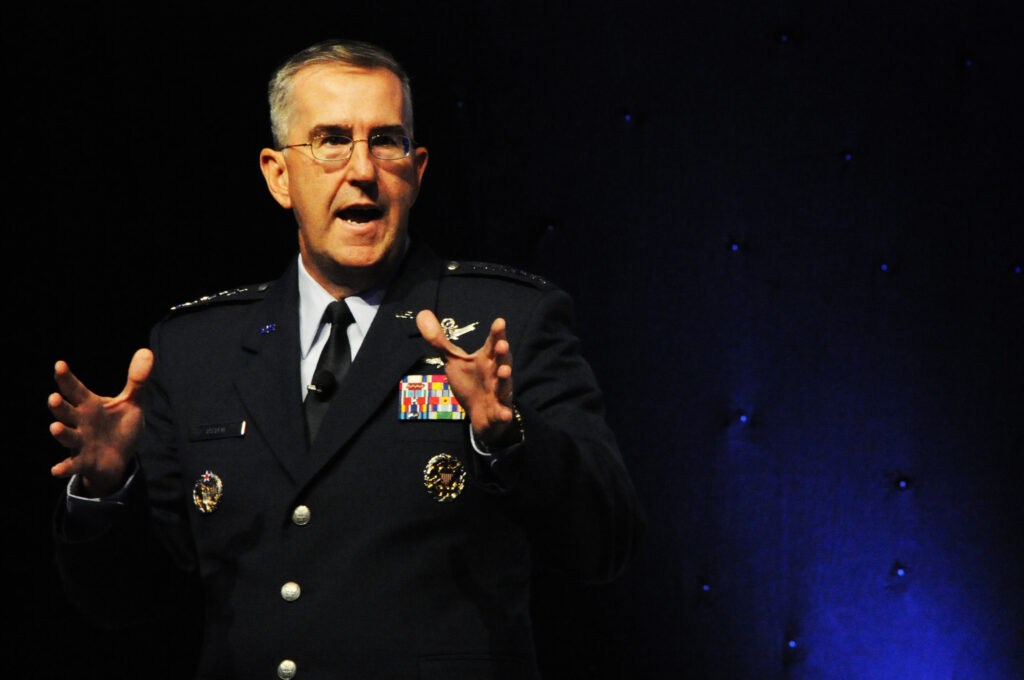THERESA HITCHENS

WASHINGTON: Vice Chairman of the Joint Chiefs of Staff Gen. John Hyten has signed four new Strategic Directives’ that set top-level, joint requirements for All Domain Operations. It’s a first step in implementing the new Joint Warfighting Concept (JWC) defining how the US will fight future wars.
“Together, the Directives provide a roadmap of the capabilities and attributes the Joint Force will need to succeed in the 21st century,” a spokesperson for Hyten said in an email. “The JROC [Joint Requirements Oversight Council] Members — the Vice Chairman and the Vice Chiefs of each of the Services — worked together closely over a year to design these requirements. This is a key milestone in the implementation of the new Joint Warfighting Concept.”
The four directives will guide the services in implementing the four key tenets of the JWC: joint fires, Joint All Domain Command and Control (JADC2), contested logistics and information advantage. They also represent a new set of teeth for the JROC to keep the services aligned with military commanders’ needs — not always an easy task as the service’s jockey for primacy of turf and budgets.
In a presentation to the Joint Artificial Intelligence Center (JAIC) taped before the directives were formalized, Hyten stressed that their contents “will be mandatory compliant to all the services — all the services will meet the elements that are embedded in all of them.”
At the same time, he explained, the Joint Warfighting Concept, signed by JCS Chairman Gen. Mark Milley on March 31 and approved shortly thereafter by Defense Secretary Lloyd Austin, is a work in progress.
“The chairman signed version 1.0 and the Secretary of Defense has blessed it, and given us guidance for version 2.0 this year as we move forward,” he said. “It is an excellent concept, but the concept is just that — it’s a concept. That concept is going to drive experimentation. It’s going to drive future capabilities and future doctrine. But right now it’s just the concept and we’re still learning with it.”
However, Hyten elaborated, the root of the JWC now and for the future is “expanded maneuver across time and space.”
The time element will be particularly important for military commanders in future All Domain Operations — globalized war with peer adversaries Russia and China, where split-second decisions will be de rigueur. This is why data management and data sharing are so crucial to the JWC, Hyten said.
Thus, embedded in all the directives, but in particular for information advantage, will be data requirements — as “aligned with” DoD’s data policy outlined in a May 5 memo from Deputy Secretary Kathleen Hicks. The memo sets out a series of “data decrees” for ensuring that data developed by the Pentagon is “visible, accessible, understandable, linked, trustworthy, interoperable, and secure.” The goal, as Hyten has articulated on several recent occasions, is to maximize data sharing and accessibility.
“The simple requirement will be from this day forward, all data produced by the Department of Defense, all data produced by every weapon system in the Department of Defense will be accessible, period,” he said. “It has to be that way. There can be no other alternative. And the reason it has to be that way is because without that data, and without that data accessibility, we will not achieve the speed that we need to deal with the future that we face.”
Further, Hyten explained, “artificial intelligence will be critical to enabling us to achieve the Joint Warfighting Concept” because it allows the vast amounts of data flowing in from military sensors on the ground, in the air, at sea, in space and in cyberspace to be crunched more rapidly than humans could.
Finally, Hyten stressed that a key gap to be filled will be an increased domestic capability to produce high-speed, cyber-protected microprocessors. Currently, he explained, cutting-edge microprocessors are largely being produced abroad, such as in South Korea and Taiwan.
“We need to have that capability here in the United States — we need to be able to build it, build it at scale, and to apply it to the problems that we face, and then we have to make sure that it’s secure,” he said.
No comments:
Post a Comment